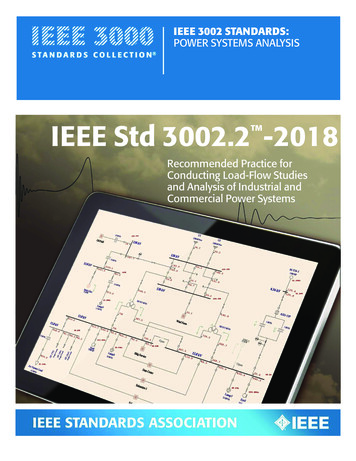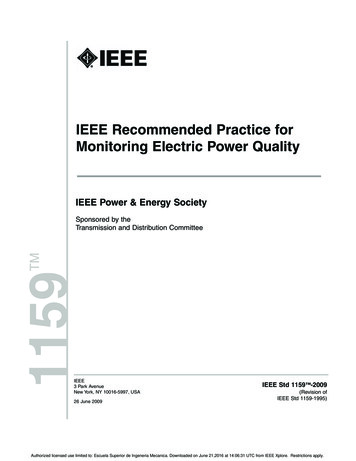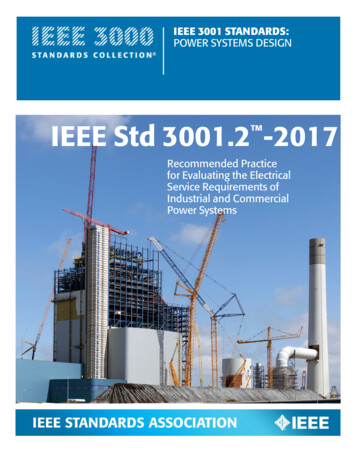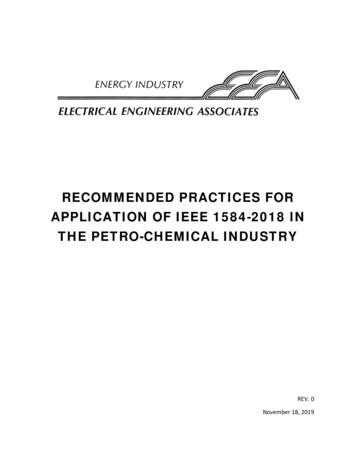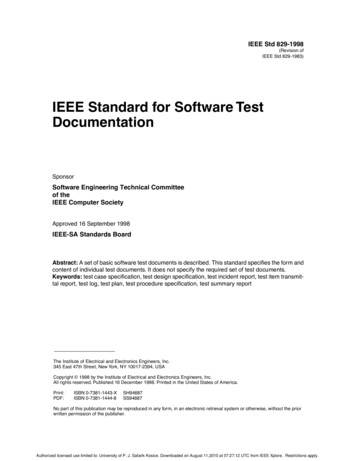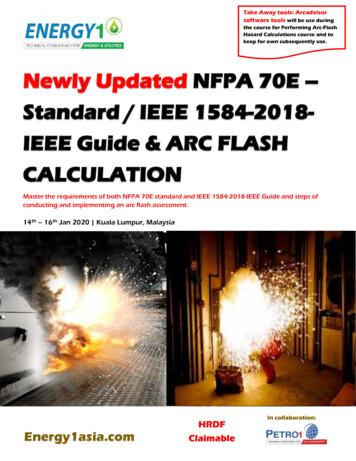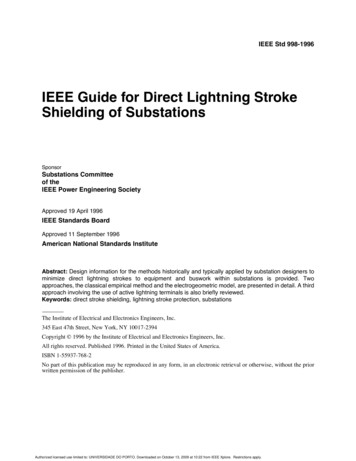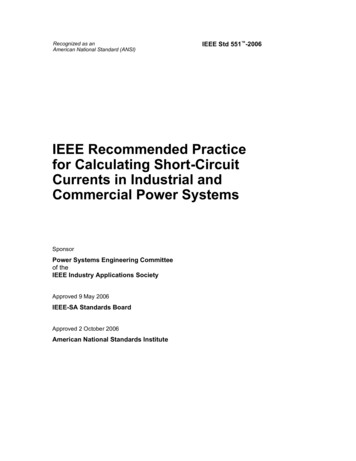
Transcription
Recognized as anAmerican National Standard (ANSI)IEEE Std 551 -2006IEEE Recommended Practicefor Calculating Short-CircuitCurrents in Industrial andCommercial Power SystemsSponsorPower Systems Engineering Committeeof theIEEE Industry Applications SocietyApproved 9 May 2006IEEE-SA Standards BoardApproved 2 October 2006American National Standards Institute
ContentsChapter 1Introduction . 11.1 Scope. 11.2 Definitions . 21.3 Acronyms and abbreviations . 81.4 Bibliography . 101.5 Manufacturers’ data sources . 11Chapter 2Description of a short-circuit current . 132.1 Introduction. 132.2 Available short-circuit . 132.3 Symmetrical and asymmetrical currents. 142.4 Short-circuit calculations . 172.5 Total short-circuit current . 202.6 Why short-circuit currents are asymmetrical. 222.7 DC component of short-circuit currents . 222.8 Significance of current asymmetry . 222.9 The application of current asymmetry information . 232.10 Maximum peak current . 242.11 Types of faults . 312.12 Arc resistance. 322.13 Bibliography . 34Chapter 3Calculating techniques . 373.1 Introduction. 373.2 Fundamental principles. 373.3 Short-circuit calculation procedure. 423.4 One-line diagram . 433.5 Per-unit and ohmic manipulations . 503.6 Network theorems and calculation techniques . 523.7 Extending a three-phase short-circuit calculation procedures programto calculate short-circuit currents for single-phase branches. 673.8 Representing transformers with non-base voltages . 693.9 Specific time period and variations on fault calculations . 783.10 Determination of X/R ratios for ANSI fault calculations. 813.11 Three winding transformers. 813.12 Duplex reactor . 823.13 Significant cable lengths. 833.14 Equivalent circuits . 843.15 Zero sequence line representation . 853.16 Equipment data required for short-circuit calculations . 863.17 Bibliography . 94viiiCopyright 2006 IEEE. All rights reserved.
Chapter 4Calculating short-circuit currents for systems without ac delay. 954.1 Introduction. 954.2 Purpose. 954.3 ANSI guidelines. 964.4 Fault calculations . 974.5 Sample calculations . 984.6 Sample computer printout. 1034.7 Conclusions. 1134.8 Bibliography . 114Chapter 5Calculating ac short-circuit currents for systems with contributions fromsynchronous machines . 1155.1 Introduction. 1155.2 Purpose. 1155.3 ANSI guidelines. 1155.4 Fault calculations . 1165.5 Nature of synchronous machine contributions . 1165.6 Synchronous machine reactances . 1195.7 One-line diagram data. 1215.8 Sample calculations . 1215.9 Sample computer printout. 1235.10 Sample computer printout for larger system calculations . 1245.11 Conclusions. 1265.12 Bibliography . 126Chapter 6Calculating ac short-circuit currents for systems with contributions frominduction motors . 1276.1 Introduction. 1276.2 Purpose. 1276.3 ANSI guidelines. 1276.4 Fault calculations . 1296.5 Nature of induction motor contributions . 1296.6 Large induction motors with prolonged contributions . 1326.7 Data accuracy. 1336.8 Details of induction motor contribution calculations according toANSI standard application guides. 1336.9 Recommended practice based on ANSI-approved standards for representinginduction motors in multivoltage system studies . 1356.10 One-line diagram data. 1376.11 Sample calculations . 1386.12 Sample computer printout. 1426.13 Bibliography . 145Copyright 2006 IEEE. All rights reserved.ix
Chapter 7Capacitor contributions to short-circuit currents . 1477.1 Introduction. 1477.2 Capacitor discharge current . 1477.3 Transient simulations . 1497.4 Summary . 1657.5 Bibliography . 165Chapter 8Static converter contributions to short-circuit currents. 1678.1 Introduction. 1678.2 Definitions of converter types. 1678.3 Converter circuits and their equivalent parameters . 1688.4 Short-circuit current contribution from the dc system to anac short circuit. 1708.5 Analysis of converter dc faults . 1768.6 Short circuit between the converter dc terminals. 1778.7 Arc-back short circuits. 1878.8 Examples. 1918.9 Conclusions. 1978.10 Bibliography . 197Chapter 9Calculating ac short-circuit currents in accordance with ANSI-approved standards . 1999.1 Introduction. 1999.2 Basic assumptions and system modeling. 1999.3 ANSI recommended practice for ac decrement modeling. 2009.4 ANSI practice for dc decrement modeling . 2049.5 ANSI-conformable fault calculations . 2129.6 ANSI-approved standards and interrupting duties. 2149.7 One-line diagram layout and data . 2169.8 First cycle duty sample calculations . 2199.9 Interrupting duty sample calculations. 2239.10 Applying ANSI calculations to non-60 Hz systems . 2289.11 Normative references . 2299.12 Bibliography . 230Chapter 10Application of short-circuit interrupting equipment . 23110.1 Introduction. 23110.2 Purpose. 23110.3 Application considerations . 23110.4 Equipment data . 23310.5 Fully rated systems . 23410.6 Low voltage series rated equipment . 23410.7 Low voltage circuit breaker short-circuit capabilities less than rating . 23510.8 Equipment checklist for short-circuit currents evaluation . 236xCopyright 2006 IEEE. All rights reserved.
10.9 Equipment phase duty calculations . 23710.10 Equipment ground fault duty calculations. 24510.11 Capacitor Switching . 24510.12 Normative references . 246Chapter 11Unbalanced short-circuit currents . 24911.1 Introduction . 24911.2 Purpose . 24911.3 ANSI guidelines . 25011.4 Procedure . 25111.5 Connection of sequence networks . 25711.6 Sample calculations . 25811.7 Conclusions . 27111.8 Bibliography . 271Chapter 12Short-circuit calculations unser international standards . 27312.1 Introduction . 27312.2 System modeling and methodologies. 27312.3 Voltage factors . 27512.4 Short circuit currents per IEC 60909. 27512.5 Short circuits “far from generator”. 27612.6 Short circuits “near generator” . 28112.7 Influence of the motors. 29012.8 Fault calculations in complex systems . 29212.9 Comparing the ANSI-approved standards with IEC 909. 29212.10 Sample calculations. 29312.11 Normative references . 29912.12 Bibliography. 300Copyright 2006 IEEE. All rights reserved.xi
IEEE Recommended Practicefor Calculating Short-CircuitCurrents in Industrial andCommercial Power SystemsChapter 1Introduction1.1 ScopeElectric power systems in industrial plants and commercial and institutional buildings aredesigned to serve loads in a safe and reliable manner. One of the major considerations inthe design of a power system is adequate control of short circuits or faults as they arecommonly called. Uncontrolled short-circuits can cause service outage withaccompanying production downtime and associated inconvenience, interruption ofessential facilities or vital services, extensive equipment damage, personnel injury orfatality, and possible fire damage.Short-circuits are caused by faults in the insulation of a circuit, and in many cases an arcensues at the point of the fault. Such an arc may be destructive and may constitute a firehazard. Prolonged duration of arcs, in addition to the heat released, may result in transientovervoltages that may endanger the insulation of equipment in other parts of the system.Clearly, the fault must be quickly removed from the power system, and this is the job ofthe circuit protective devices—the circuit breakers and fusible switches.A short-circuit current generates heat that is proportional to the square of the currentmagnitude, I2R. The large amount of heat generated by a short-circuit current may damagethe insulation of rotating machinery and apparatus that is connected into the faultedsystem, including cables, transformers, switches, and circuit breakers. The mostimmediate danger involved in the heat generated by short-circuit currents is permanentdestruction of insulation. This may be followed by actual fusion of the conducting circuit,with resultant additional arcing faults.Copyright 2006 IEEE. All rights reserved.1
IEEEStd 551-2006CHAPTER 1The heat that is generated by high short-circuit currents tends not only to impair insulatingmaterials to the point of permanent destruction, but also exerts harmful effects upon thecontact members in interrupting devices.The small area common between two contact members that are in engagement dependsmainly upon the hardness of the contact material and upon the amount of pressure bywhich they are kept in engagement. Owing to the concentration of the flow of current atthe points of contact engagement, the temperatures of these points reached at the times ofpeak current are very high. As a result of these high spot temperatures, the material ofwhich the contact members are made may soften. If, however, the contact material iscaused to melt by excessive I2R losses, there is an imminent danger of welding thecontacts together rendering it impossible to separate the contact members when the switchor circuit breaker is called upon to open the circuit. Since it requires very little time toestablish thermal equilibrium at the small points of contact engagement, the temperature atthese points depends more upon the peak current than upon the rms current. If the peakcurrent is sufficient to cause the contact material to melt, resolidification may occurimmediately upon decrease of the current from its peak value.Other important effects of short-circuit currents are the strong electromagnetic forces ofattraction and repulsion to which the conductors are subjected when short-circuit currentsare present. These forces are proportional to the square of the current and may subject anyrotating machinery, transmission, and switching equipment to severe mechanical stressesand strains. The strong electromagnetic forces that high short-circuit currents exert uponequipment can cause deformation in rotational machines, transformer windings, andequipment bus bars, which may fail at a future time. Deformation in breakers and switcheswill cause alignment and interruption difficulties.Modern interconnected systems involve the operation in parallel of large numbers ofsynchronous machines, and the stability of such an interconnected system may be greatlyimpaired if a short-circuit in any part of the system is allowed to prevail. The stability of asystem requires short fault clearing times and can be more limiting than the longer timeconsiderations imposed by thermal or mechanical effects on the equipment.1.2 DefinitionsFor the purpose of this document, the following terms and definitions apply. The Authoritative Dictionary of IEEE Standards Terms [B3]1 should be referenced for terms notdefined in this clause.1.2.1 30 cycle time: The time interval between the time when the actuating quantity of therelease circuit reaches the operating value, and the approximate time when the primaryarcing contacts have parted. The time period considers the ac decaying component of afault current to be negligible.1The numbers in brackets correspond to those of the bibliography in 1.4.2Copyright 2006 IEEE. All rights reserved.
INTRODUCTIONIEEEStd 551-20061.2.2 arcing time: The interval of time between the instant of the first initiation of the arcand the instant of final arc extinction in all poles.1.2.3 armature: The main current carrying winding of a machine, usually the stator.1.2.4 armature resistance: Ra—The direct current armature resistance. This isdetermined from a dc resistance measurement. The approximate effective ac resistance is1.2Ra.1.2.5 asymmetrical current: The combination of the symmetrical component and thedirect current component of the current.1.2.6 available current: The current that would flow if each pole of the breaking deviceunder consideration were replaced by a link of negligible impedance without any changeof the circuit or the supply.1.2.7 breaking current: The current in a pole of a switching device at the instant of thearc initiation. Better known as interrupting current.1.2.8 circuit breaker: A switching device capable of making, carrying, and breakingcurrents under normal circuit conditions and also making, carrying for a specified time,and breaking currents under specified abnormal conditions such as those of short circuit.1.2.9 clearing time: The total time between the beginning of specified overcurrent and thefinal interruption of the circuit at rated voltage. In regard to fuses, it is the sum of theminimum melting time of a fuse plus tolerance and the arcing time. In regard to breakersunder 1000 V, it is the sum of the sensor time, plus opening time and the arcing time. Forbreakers rated above 1000 V, it is the sum of the minimum relay time (usually 1/2 cycle),plus contact parting time and the arcing time. Sometimes referred to as total clearing timeor interrupting time.1.2.10 close and latch: The capability of a switching device to close (allow current flow)and immediately thereafter latch (remain closed) and conduct a specified current throughthe device under specified conditions.1.2.10.1 close and latch duty: The maximum rms value of calculated short-circuit currentfor medium- and high-voltage circuit breakers during the first cycle with any applicablemultipliers for fault current X/R ratio. Often the close and latching duty calculation is simplified by applying a 1.6 factor to the calculated breaker first cycle symmetrical ac rmsshort-circuit current. Also called first cycle duty (formerly, momentary duty).1.2.10.2 close and latch rating: The maximum current capability of a medium orhigh-voltage circuit breaker to close and immediately thereafter latching closed fornormal-frequency making current. The close and latching rating is 1.6 times the breakerrated maximum symmetrical interrupting current in ac rms amperes or a peak current thatis 2.7 times ac rms rated maximum symmetrical interrupting current. Also called firstcycle rating (formerly, momentary rating).Copyright 2006 IEEE. All rights reserved.3
IEEEStd 551-2006CHAPTER 11.2.11 contact parting time: The interval between the time when the actuating quantity inthe release circuit reaches the value causing actuation of the release and the instant whenthe primary arcing contacts have parted in all poles. Contact parting time is the numericalsum of release delay and opening time.1.2.12 crest current: The highest instantaneous current during a period. Syn: peakcurrent.1.2.13 direct axis: The machine axis that represents a plane of symmetry in line with theno-load field winding.1.2.14 direct axis subtransient reactance: X"dv (saturated, rated voltage) is the apparentreactance of the stator winding at the instant short-circuit occurs with the machine at ratedvoltage, no load. This reactance determines the current flow during the first few cyclesafter short-circuit.1.2.15 direct axis subtransient reactance: X"di (unsaturated, rated current) is thereactance that is determined from the ratio of an initial reduced voltage open circuitcondition and the currents from a three-phase fault at the machine terminals at ratedfrequency. The initial open-circuit voltage is adjusted so that rated current is obtained. Theimpedance is determined from the currents during the first few cycles.1.2.16 direct axis transient reactance: X'dv (saturated, rated voltage) is the apparentreactance of the stator winding several cycles after initiation of the fault with the machineat rated voltage, no load. The time period for which the reactance may be considered X'dvcan be up to a half (1/2) second or longer, depending upon the design of the machine andis determined by the machine direct-axis transient time constant.1.2.17 direct axis transient reactance: X'di (unsaturated, rated current) is the reactancethat is determined from the ratio of an initial reduced voltage open circuit condition andthe currents from a three-phase fault at the machine terminals at rated frequency. Theinitial open-circuit voltage is adjusted so that rated current is obtained. The initial highdecrement currents during the first few cycles are neglected.1.2.18 fault: A current that flows from one conductor to ground or to another conductorowing to an abnormal connection (including an arc) between the two. Syn: short circuit.1.2.19 fault point angle: The calculated fault point angle (Tan–1(X/R ratio) using complex(R jX) reactance and resistance networks for the X/R ratio.1.2.20 fault point X/R: The calculated fault point X/R ratio using separate reactance andresistance networks.1.2.21 field: The exciting or magnetizing winding of a machine.1.2.22 first cycle duty: The maximum value of calculated short-circuit current for the firstcycle with any applicable multipliers for fault current X/R ratio.4Copyright 2006 IEEE. All rights reserved.
INTRODUCTIONIEEEStd 551-20061.2.23 first cycle rating: The maximum current capability of a piece of equipment duringthe first cycle of a fault.1.2.24 frequency: The rated frequency of a circuit.1.2.25 fuse: A device that protects a circuit by melting open its current-carrying elementwhen an overcurrent or short-circuit current passes through it.1.2.26 high voltage: Circuit voltages over nominal 34.5 kV.NOTE—ANSI standards are not unanimous in establishing the threshold of “high-voltage.”21.2.27 impedance: The vector sum of resistance and reactance in an ac circuit.1.2.28 interrupting current: The current in a pole of a switching device at the instant ofthe arc initiation. Sometime referred to as breaking current.1.2.29 interrupting time: The interval between the time when the actuating device “sees”or responds to a operating value, the opening time and arcing time. Sometimes referred toas total break time or clearing time.1.2.30 low voltage: Circuit voltage under 1000 V.1.2.31 maximum rated voltage: The upper operating voltage limit for a device.1.2.32 medium voltage: Circuit voltage greater than 1000 V up to and including 34.5 kV.NOTE—ANSI standards are not unanimous in establishing the threshold of “high-voltage.”1.2.33 minimum rated voltage: The lower operating voltage limit for a device where therated interrupting current is a maximum. Operating breakers at voltages lower thanminimum rated voltage restricts the interrupting current to maximum rated interruptingcurrent.1.2.34 momentary current rating: The maximum rms current measured at the majorpeak of the first cycle, which the device or assembly is required to carry. Momentaryrating was used on medium- and high-voltage breakers manufactured before 1965. Seepresently used terminology of close and latch rating.1.2.35 momentary current duty: See presently used terminology of close and latchduty. Used for medium- and high-voltage breaker duty calculations for breakersmanufactured before 1965.1.2.36 negative sequence: A set of symmetrical components that have the angular phaselag from the first member of the set to the second and every other member of the set equalto the characteristic angular phase difference and rotating in the reverse direction of the2Notes in text, tables, and figures are given for information only and do not contain requirements needed toimplement the standard.Copyright 2006 IEEE. All rights reserved.5
IEEEStd 551-2006CHAPTER 1original vectors. For a three-phase system, the angular different is 120 degrees. See also:symmetrical components.1.2.37 negative sequence reactance: X2v (saturated, rated voltage). The rated currentvalue of negative-sequence reactance is the value obtained from a test with a fundamentalnegative-sequence current equal to rated armature current (of the machine). The ratedvoltage value of negative-sequence reactance is the value obtained from a line-to-lineshort-circuit test at two terminals of the machine at rated speed, applied from no load atrated voltage, the resulting value being corrected when necessary for the effect ofharmonic components in the current.1.2.38 offset current: A current waveform whose baseline is offset from the
American National Standard (ANSI) IEEE Std 551 -2006 IEEE Recommended Practice for Calculating Short-Circuit Currents in Industrial and Commercial Power Systems Sponsor Power Systems Engineering Committee of the IEEE Industry Applications Society Approved 9 May 2006 IEEE-SA Standards Boar
